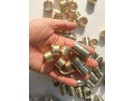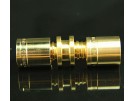Industry News
01
In a piping system, multiple pipes and pipe sections need to be connected to each other for the system to work effectively. This purpose is achieved through pipe fittings, which are specially used to connect straight pipe sections and pipes of different shapes and sizes.


02
What are the different processes involved in the production of brass fittings?
There are many processes involved in making high quality brass fittings. Here are the most common processes in its production:
1. Evaporation model casting: As the name suggests, evaporation technology is used in this casting process.
2. Centrifugal casting: This casting technique is most common when manufacturing thin-walled cylinders. The centrifugal casting process is also called a spin casting process.
3. Continuous casting: In this casting process, the molten metal solidifies, helping them to obtain the final finish. The continuous casting process is also called casting.
4. Die-casting: This is another metal casting process. During this process, molten metal under high pressure passes through the mold.
How much do you know about the basics of brass fittings?
03
What components are required for brass fittings?

1. Coupling: A coupling is a component used to connect two pipes. You can get these components in different lengths and sizes.
2. Nipple: The nipple is basically a tube. It is used to connect two fittings and is most commonly used in pipe solutions. The assembly is made of copper or chlorinated polyvinyl chloride.
3. T-shirt: Tee is another important plumbing fitting for providing a stable flow of any liquid.
4. Reducer: When you want to connect two pipes with different widths. In this case, use a reducer.
5. Elbow: This part has the shape of a human elbow. It is used to change the direction of the pipe by 45 ° or 90 °.
6. Cross: As the name suggests, this component has a cross shape, and the four branches are in opposite directions. One of the four crosses is used as the entrance and the remaining three branches are used as the exit.
7.Union: The pipeline needs to be disconnected during maintenance, fixture or replacement. There is also a component for this purpose. Unions are components used to disconnect pipes when needed for the purposes described above.













